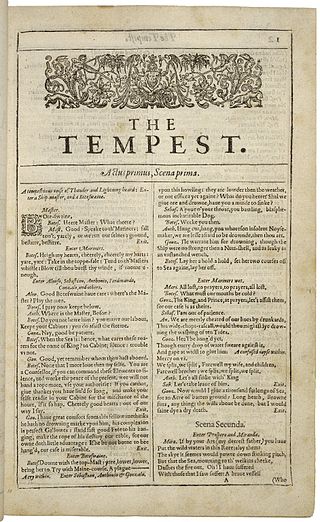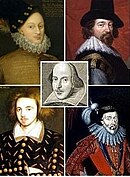Related Research Articles

The Oxfordian theory of Shakespeare authorship contends that Edward de Vere, 17th Earl of Oxford, wrote the plays and poems of William Shakespeare. While historians and literary scholars overwhelmingly reject alternative authorship candidates, including Oxford, public interest in the Oxfordian theory continues. After the 1920s, the Oxfordian theory became the most popular alternative Shakespeare authorship theory.

Irvin Leigh Matus was an independent scholar, autodidact, and author. He is best known as an authority on Shakespeare, but also wrote about aspects of Brooklyn's history such as the Vitagraph Studios, and developed a method of modelling baseball statistics. He was a scholar-in-residence at Shepherd University for the academic year 1992-1993. He was based in Washington, DC.

John Thomas Looney (luni) was an English school teacher who is notable for having originated the Oxfordian theory, which claims that Edward de Vere, 17th Earl of Oxford (1550–1604) was the true author of Shakespeare's plays.
James S. Shapiro is Professor of English and Comparative Literature at Columbia University who specializes in Shakespeare and the Early Modern period. Shapiro has served on the faculty at Columbia University since 1985, teaching Shakespeare and other topics, and he has published widely on Shakespeare and Elizabethan culture.
Charlton Ogburn Jr. was an American writer, most notably of memoirs and non-fiction works. Before he established himself as a writer he served in the US army, and then as a State Department official, specialising in South-East Asian affairs.

The Shakespeare Fellowship was the name used by an organisation devoted to the Shakespeare authorship question. Originally it sought to represent all alternatives to the mainstream consensus that William Shakespeare authored the plays attributed to him, but it later became strongly identified with Oxfordian theory: promoting Edward de Vere, 17th Earl of Oxford, as the true author of the works of Shakespeare. The original organisation is now known as "The Shakespearean Authorship Trust".

The Prince Tudor theory is a variant of the Oxfordian theory of Shakespeare authorship, which asserts that Edward de Vere, 17th Earl of Oxford, was the true author of the works published under the name of William Shakespeare. The Prince Tudor variant holds that Oxford and Queen Elizabeth I were lovers and had a child who was raised as Henry Wriothesley, 3rd Earl of Southampton. The theory followed earlier arguments that Francis Bacon was a son of the queen. A later version of the theory, known as "Prince Tudor II" states that Oxford was himself a son of the queen, and thus the father of his own half-brother.
Charles Wisner Barrell was an American writer. He first became significant as an art critic, promoting realism. He later built a career as an early exponent of public relations and as a documentary film maker.

The Tempest is a play by William Shakespeare, probably written in 1610–1611, and thought to be one of the last plays that he wrote alone. After the first scene, which takes place on a ship at sea during a tempest, the rest of the story is set on a remote island, where Prospero, a wizard, lives with his daughter Miranda, and his two servants: Caliban, a savage monster figure, and Ariel, an airy spirit. The play contains music and songs that evoke the spirit of enchantment on the island. It explores many themes, including magic, betrayal, revenge, and family. In Act IV, a wedding masque serves as a play-within-a-play, and contributes spectacle, allegory, and elevated language.
The Declaration of Reasonable Doubt is an Internet signing petition which seeks to enlist broad public support for the Shakespeare authorship question to be accepted as a legitimate field of academic inquiry. The petition was presented to William Leahy of Brunel University by the actors Derek Jacobi and Mark Rylance on 8 September 2007 in Chichester, England, after the final matinee of the play I Am Shakespeare on the topic of the bard's identity, featuring Rylance in the title role. As of 23 April 2016, the 400th anniversary of Shakespeare's death and the original self-imposed deadline, the document had been signed by 3,348 people, including 573 self-described current and former academics. As of December 2022, the count stood at 5,128 total signatures.

The Ashbourne portrait is one of several portraits that have been falsely identified as portrayals of William Shakespeare. At least 60 such works had been offered for sale to the National Portrait Gallery in the 19th century within the first forty years of its existence; the Ashbourne portrait was one of these. The portrait is now a part of the collection of the Folger Shakespeare Library in Washington, DC.

True Reportory is the short-title of a 24,000 word early American colonial narrative, A true reportory of the wracke, and redemption of Sir Thomas Gates Knight; vpon, and from the Ilands of the Bermudas: his comming to Virginia, and the estate of that Colonie then, and after, vnder the gouernment of the Lord La Warre, Iuly 15. 1610. The author William Strachey was a passenger on the Sea Venture, the flagship of the supply fleet that sailed to the English colony of Virginia from Plymouth in June 1609. During a hurricane it wrecked off the coast of Bermuda, where the survivors built two pinnaces, Patience and Deliverance, to continue the journey. They arrived in Jamestown in May 1610 and found the colony suffering from famine and Indian attacks that had reduced the 600 colonists to fewer than 70. True Reportory is Strachey's account of these incidents, first published in 1625 in an anthology of new world colonial literature assembled by Samuel Purchas.

Note: In compliance with the accepted terminology used within the Shakespeare authorship question, this article uses the term "Stratfordian" to refer to the position that William Shakespeare of Stratford-upon-Avon was the primary author of the plays and poems traditionally attributed to him. The term "anti-Stratfordian" is used to refer to the theory that some other author, or authors, wrote the works.
Lynne Kositsky is a Canadian author of poetry and young adult historical fiction. Kositsky, who was born in Montreal, Quebec and grew up in London, England, now lives in the Niagara region of Ontario. As of 2010 she has published ten novels, set in such varied historical contexts as Ireland during the Great Famine of the 1840s, Nova Scotia during the early 19th century, Elizabethan London, and the Holocaust.
Louis Paul Bénézet (1878–1961) was an American educator and writer who pioneered the reform of school education in the early twentieth century.

The Shakespeare authorship question is the argument that someone other than William Shakespeare of Stratford-upon-Avon wrote the works attributed to him. Anti-Stratfordians—a collective term for adherents of the various alternative-authorship theories—believe that Shakespeare of Stratford was a front to shield the identity of the real author or authors, who for some reason—usually social rank, state security, or gender—did not want or could not accept public credit. Although the idea has attracted much public interest, all but a few Shakespeare scholars and literary historians consider it a fringe theory, and for the most part acknowledge it only to rebut or disparage the claims.
Percy Allen (1875–1959) was an English journalist, writer and lecturer most notable for his advocacy of the Oxfordian theory of Shakespeare authorship, and particularly for his creation of Prince Tudor theory, which claimed that the Earl of Oxford fathered a child with Queen Elizabeth I.
Bernard Mordaunt Ward was a British author and third-generation soldier most noted for his support of the Oxfordian theory of Shakespeare authorship and writing the first documentary biography of Edward de Vere, 17th Earl of Oxford.
References
- ↑ "Dr. Roger Stritmatter" Archived 2015-09-23 at the Wayback Machine , Faculty Profiles, Coppin State University. Retrieved 29 October 2015.
- ↑ Shapiro, James (2010). Contested Will: Who Wrote Shakespeare? UK edition: Faber and Faber ISBN 978-0-571-23576-6 (US edition: Simon & Schuster ISBN 978-1-4165-4162-2), p. 207 (196).
- ↑ Matus, Irvin. "The Oxfordian Hamlet: The Playwright's the Thing". The Shakespeare Authorship Page. David Kathman and Terry Ross. Retrieved 10 November 2011.
- ↑ "Curriculum Vitae" Archived 2011-12-23 at the Wayback Machine , Shake-speare’s Bible.com, accessed 10 Nov 2011.
- ↑ Shapiro 2010, pp. 228-9 (215).
- ↑ "Bible FAQ". Shake-speare’s Bible.com. Retrieved 10 November 2011.
- ↑ Anderson, Mark (2005). "Shakespeare" by Another Name: The Life of Edward de Vere, Earl of Oxford, The Man Who Was Shakespeare. Gotham ISBN 978-1-5924-0103-1, pp=381—2.
- ↑ Egan, Gabriel, "Shakespeare" in Years Work Eng Studies 2009:88, 345–486; Sec. I, 392–93.
- ↑ Vaughan, Virginia, and Alden T., eds. (1999) The Tempest, The Arden Shakespeare, 3rd Series, p. 87.
- ↑ Vaughan, Alden T. (2008). "William Strachey's 'True Reportory' and Shakespeare: A Closer Look at the Evidence". Shakespeare Quarterly . 59 (3). Folger Shakespeare Library: 245–273. doi:10.1353/shq.0.0017. eISSN 1538-3555. ISSN 0037-3222. JSTOR 40210277. S2CID 161199723.
